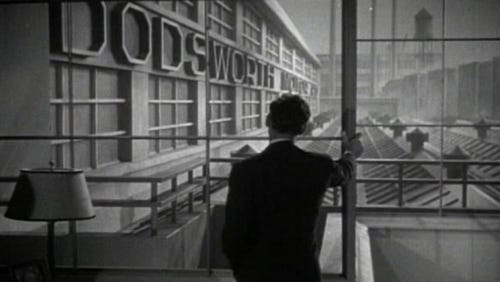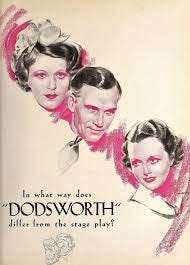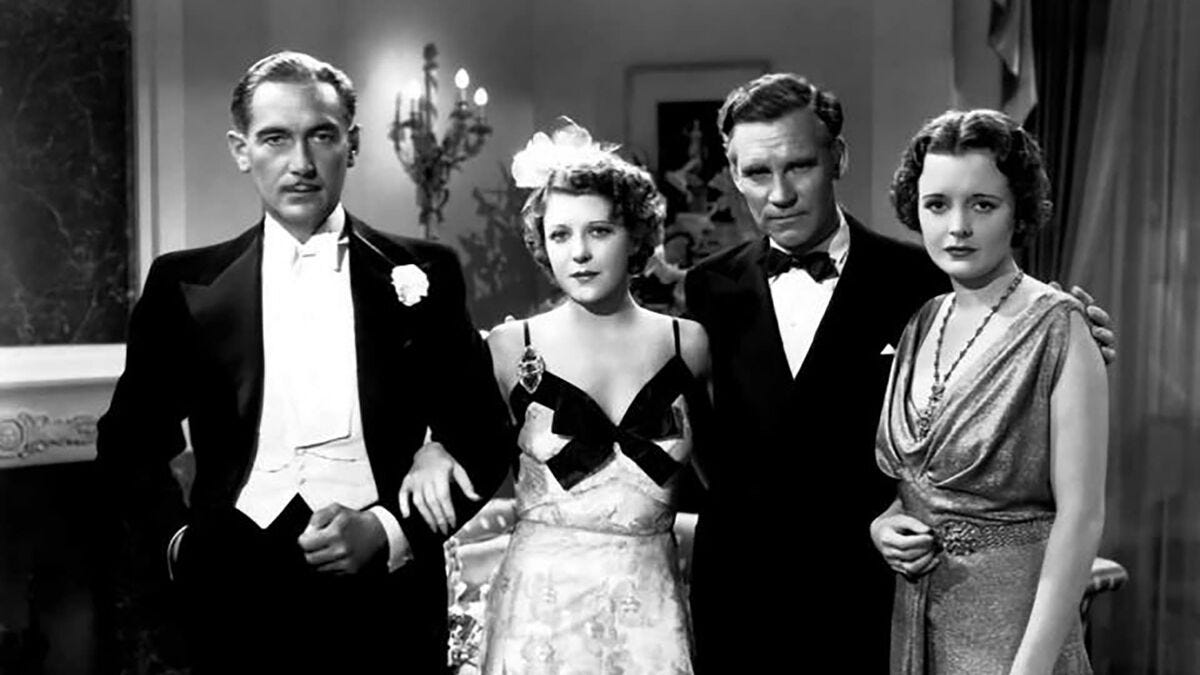Editor’s note: The Timbuktu Review is a gathering one-pot cooking, a convenient store that sells both gas and chicken, a place where text mixes with curiosity and experiences. Analog travel and the human written word. It is also a selfish act of me wanting to read my friends, so this becomes a gathering spot for a literary community, a village flagpole, a place to staple an idea or thought up and say to all “read this, it is a human thought with all its foibles.” The goal: to promote the most exciting writers I know and to support ambitious, inquisitive readers.
Something to share? Keen on writing an essay, a wee missive? Send submissions to thetimbuktureview@substack.com and we will take a gander to see if it fits. The below is from friend and writer Benson Cowan, and well worth a goosey gander.
Like many films from the 1930s, Dodsworth, directed by William Wyler in 1936, offers us silvery images of lost worlds. The houses of the elite in middle America. Grand restaurants and dancehalls. And the staterooms of luxury ocean liners.
On his first night at sea on what appears to have been the inaugural voyage of the Queen Mary, Samuel Dodsworth, a self-assured, self-made captain of industry, comes down to dinner. He is dressed in a white tie and tails.The rest of the passengers are wearing more casual clothing – light flannels, tweeds, baggy suits. He laughs it off and smokes a cigarette. When Fran, his younger, restless, status-conscious wife, arrives, dressed in her full-shouldered formal finery, she is mortified.
“We can’t be expected to know all the tricks the first trip over.” Dodsworth tells her, adding to her mortification.
Sam Dodsworth is played by Walter Huston, a rangy, granite-hewn, Canadian actor, who would be nominated for an Academy Award for his performance. Huston, like a lot of performers of his generation had worked the vaudeville circuit as a song and dance man before finding success on Broadway. His deep, clear voice led him to the moving pictures where he thrived, ultimately winning an Oscar for his portrayal of the old prospector in The Treasure of the Sierra Madre, directed by his son.
Huston played Dodsworth on Broadway and he steps into the movie and the character like a man wearing a favourite old suit. Sam Dodsworth is in his early 50s and, after 30 years of building his automobile manufacturing company he is selling out to a big consortium in Detroit. He is tired and, for the first time in his life, uncertain as to what’s next. His wife wants to go to Europe and he agrees.
Fran Dodsworth is played by Ruth Chatterton. She had also been a Broadway actor and then moved to Los Angeles and found roles in early talkies. She was also a pioneering aviator who made solo flights across the U.S. and palled around with Amelia Earhart. A few years after Dodsworth, she retired from acting and became a successful novelist.
Chatterton plays the social climbing Fran with vulpine vigour and relish. She married an older man, raised his daughter, ran his house, and is ready to seize her one chance to live the life she always wanted. Fran is as quick and mercurial as Sam is slow and predictable.
On the ship, once they get past the mortification of the first dinner, the Dodsworths settle into their journey. Fran cavorts with the caddish Captain Lockert, played by David Niven in one of his earlier film roles, while Sam pores over maritime charts and searches for signs of land on the crossing. Fran’s flirtations with Lockert go further than she is ready to handle resulting in some pearl clutching and bruised egos. Sam meets Mary Cortwight, a bright but world-weary divorcee played by the incomparable Mary Astor, who, to his surprise, assures him that Americans like her live in Italy by the thousands.
Sam and Fran leave the ship and head to Paris. Fran ingratiates herself into the Paris social scene, revelling in the city’s haute couture and meeting the right people for tea at the finest restaurants. Sam orders eggs with his continental breakfast, reads the Paris Herald Tribune, and, Baedeker in hand, visits the tourist sites as he and Fran drift further and further apart.
While Dodsworth unpacks and critiques marriage, aging, bourgeois American values, and the desire for social status, it is fundamentally a travel movie. The characters are constantly in motion navigating the mundane inconveniences of transportatio. The anxiety and excitement of meeting new people and seeing new places, the implacability of foreigners and their customs, the ennui of being away from home, and that particular swing from abject depression to unfettered joy and back again that only happens on the road.
In Bambi v. Godzilla, David Mamet’s reflections on Hollywood, he calls Dodsworth one of four perfect movies. Another travel movie, GalaxyQuest, is also on the list. So are The Godfather and A Place in the Sun. I don’t know if it’s perfect, but for me, Dodsworth has an energy, a sharpness, and a deftness that make it a joy to return to. And it takes me back to my first trip to Europe in late January of 1994. I spent the last of my student loan money on an open ticket to Amsterdam. I can almost see myself, frozen with fear on the threshold of the adventure I had always craved. I stood outside the train station at Schiphol for hours, pacing, chainsmoking, unable to bring myself to go and buy a ticket. I didn’t know what to do. I didn’t know where to go. I couldn’t be expected to know all the tricks my first trip over.
Although the movie is almost 90 years old, there are things that are still familiar to anyone who has travelled in Europe. In particular, there is a scene in the movie where Sam fruitlessly waits for Fran at a Paris café. With the tightly packed rows of rattan chairs facing the street and the lugubrious waiter laying the change down in a small dish, it could have been shot last week.
But for the most part they are travelling through a series of lost and unfamiliar worlds. Cityscapes that have been reshaped by cars, modern buildings, tourist infrastructure and the slow creep of modernity. And social mores and unspoken rules that have long since dissolved and disappeared. Whether it is an elaborate setting for tea, a mysterious highball, an apology for asking personal questions of strangers, a small orchestra playing waltzes, or the nervous drag of a cigarette, what were once mundane objects or actions are now artifacts of long-forgotten, almost dreamlike, past.
The book that the movie was based on was written, fittingly, by an almost forgotten author, Sinclair Lewis. Lewis was a sharp observer, capturing everything in his gaze. His writing exudes a clean, unsparing worldliness and he refuses to free his characters from their hypocrisy, their frailties, and their unexamined and poorly understood urges and desires. He anticipates the existential ennui of John Cheever and the cold, photographic lens of John Updike. For a time, Lewis was about as famous as a writer could ever hope to be. He won the Pulitzer in 1925 but refused it because he thought an earlier work deserved it more. In 1930 he won the Nobel Prize for Literature and appears to have accepted it without protest or reservation. Thirty years later people just stopped reading him.
The book Dodsworth is set about ten years earlier in the late 1920s. The satire of the smug Americans is sharper than the film. Sam is a worrier and a doubter constantly feeling unliked and out of place. Fran is colder, sharper and more foolish. Mary Cortwight is a less fully realised a character than the one that Mary Astor brings to quickness in the film.
But, like the film, it is a book about travel. Sam and Fran are constantly on the move, balancing their excitement in a new locale with the weary boredom that haunts every hotel room. There are a number of truly poignant descriptions of the highs and lows of being on the road that hold up to this day. And it offers its share of artifacts of lost worlds – Americans in Paris, telegrams, casual anti-Semitism, cigarette cases, steamer trucks, dressing for dinner, social climbing grifters, and fallen aristocrats.
Both the film and the book highlight the cold reality that looking back on any travel experience is to try, unsuccessfully, to return to lost worlds. The intensity and vivacity of any moment on the road can never truly be captured in memory. We might look at pictures of younger versions of ourselves, almost unrecognisable with our thin faces, bad hair, and inexplicable clothing choices. We blur the details of the past with watercolours, brightening the record, lightening the shadows. When we do try to summon up more detail the images flicker for a moment like trying to remember a long forgotten dream.
The present destroys the past. The traveller is reborn and replaces the person they once were. We become lost to ourselves, and, at the same time, connected to some version of us that feels more real and more vital. A person that has to make choices. A person that has to wrestle with intense emotions. A person that has to engage – with the world, with other people, and with ourselves. And then the future destroys the present. It is an unrelenting wind that blows us away from the shore. The actual experience of the trip and of the self that emerged on the road collapses and fades away when we return home. We are not the same person we were when we left but neither are we that electric, essential, enervated person we were on the road. We are something in-between.
The lost worlds of the film, more so than the book, have a particular poignancy. Watching it now, we know what the characters did not - that the worlds it shows us will be all but destroyed by the war in a few short years. The caddish Major Lockert will likely rejoin the army and be rescued at Dunkirk. The Jewish financier who Fran flirts with in Paris and then Switzerland will, if he is lucky, end up an impoverished refugee in America. The down on his heels Austrian count that Fran is prepared to divorce Sam for is sure to become an officer in the German army and is unlikely to survive the coming slaughter. And Sam and Mary, who make plans to travel east to convince the Soviets to let them set up a trans-Pacific airline, will not make it to Samarkand. All the characters, all of their hopes and schemes and plans are about to be washed away by a tsunami. They are oblivious to its coming.
And this is true of the actors and the filmmaker. Their worlds are as lost to us as the worlds in the film. Before the U.S. entered the war, William Wyler would direct Mrs. Miniver, a film that Winston Churchill called “propaganda worth 100 battleships” and then joined the AirForce as chronicled in Mark Harris’ Five Came Back: A Story of Hollywood and the Second World War. After the war he directed The Best Years of Our Lives which chronicled the challenges of the return to civilian life. David Niven and John Payne, who played Sam and Fran’s son-in-law, would leave Hollywood to fight in the war. And when they returned, as Niven narrates unreliably in his memoir, The Moon’s a Balloon, Hollywood was a different place. The small, clubby industry of the 1930s was gone forever. Huston acted in a smattering of films after the war playing increasingly cantankerous old men, never again the romantic lead. Chatterton did not act in a movie again after 1939.
Dodsworth transports us to a place where those lost worlds shimmer into view for a moment or two. And it calls up equally translucent memories of our own lost worlds, reminding us of their impermanence. The cities we travelled though that have grown shinier and fuller, churning through people, changing their feel and character. The small restaurant around the corner with the gregarious Sicilian chef that is now a mobile phone shop. The lonely pub with earthen floors and a massive hearth on the edge of the moor that has long fallen into ruin. Fast friendships with strangers whose last names and faces have faded indelibly. Small dirt roads have been paved and widened. Cliff faces have eroded into the sea. Rivers we can never step into again.







